Content monetization helps creators and brands turn blog posts, short‑form videos, and other formats into income streams. Instead of chasing large follower counts, the focus shifts to converting existing content into sellable digital products and direct revenue. Higher engagement (scrolling, watching, and sharing) leads to greater earning potential, and a smart strategy can make every post part of a sustainable income plan.
Whether you’re a solo creator or part of a team, content monetization lets you monetize content creation by turning attention into income. Consistent posting and creative formats help creators unlock passive income generation and steady earnings.
More user engagement, scrolling, watching, and interacting leads to greater earning potential. With 76% of users buying products found online, strong audience engagement creates new revenue opportunities for creators and brands.
If you already create content, monetization tools can turn each post into part of your income plan. Smart content monetization strategies and platform selection allow creators to monetize existing content and build steady revenue streams without starting over.
What Is Content Monetization?
Content monetization means turning blog posts, YouTube channels, videos, and even text posts into income. Every type of content, videos, writing, or posts across social media platforms can earn money through ad revenue, affiliate marketing, sponsored content, premium content sales, and direct product sales.
It’s not just about reach: content quality, posting time, and content format all shape how you monetize content. Digital content monetization lets creators turn blog posts, videos, and social updates into sellable digital assets, such as online courses, guides, and premium digital products. As audience engagement grows, more revenue streams open up, including ads, branded content, or paid access.
Content monetization platforms like Facebook, Instagram, and YouTube now lead the way with built-in monetization programs, payout models, and creator tools. These platforms rolled out monetization tabs, performance bonuses, and tools for brand partnerships. Anyone who posts consistently and builds real audience interest can use these creator monetization strategies to earn, whether through bonuses, partnerships, or exclusive content.
Today, access is the biggest shift: Android apps and professional dashboards let anyone earn from content creation, not just million-follower stars. If you’re committed to posting and sharing, you can start earning through content monetization.
Popular Models to Earn from Your Content
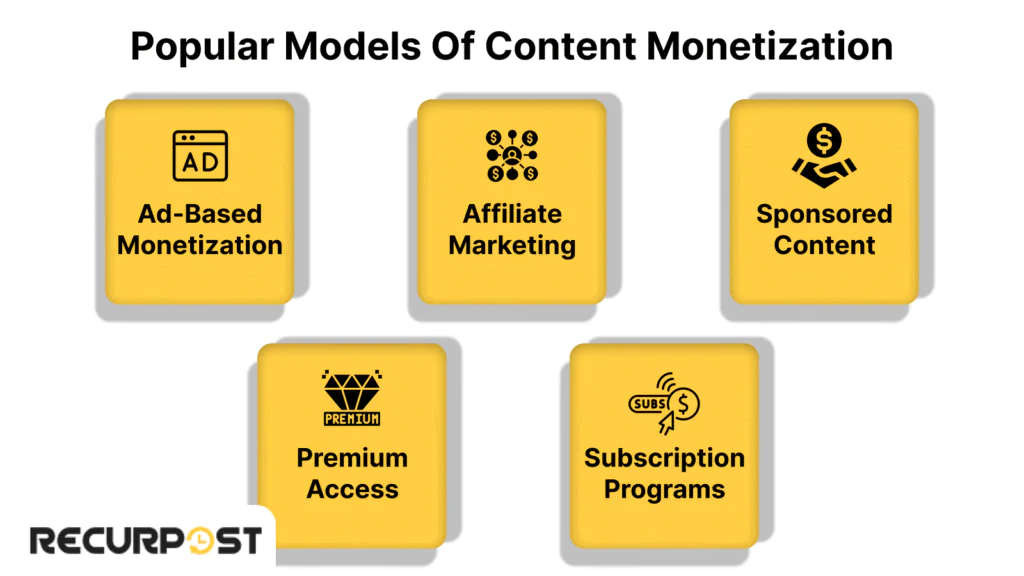
Monetizing creators now have access to multiple content monetization models across various platforms, making it easier to generate creator income from any content format. Here are the best ways to generate revenue from digital content using ad-based monetization, affiliate networks, sponsored posts, premium content sales, and membership sites:
1. Ad-Based Monetization
Best for: YouTube videos, Facebook Watch, blogs, and long-form content
Top pick for YouTube creators, blogs, and reels. Earn from Google AdSense, the YouTube Partner Program, and in-stream ads based on views, watch time, or clicks.
2. Affiliate Marketing
Best for: Product recommendation videos, blog posts, and review content
Use affiliate networks like Amazon Associates to share links in blog posts, YouTube videos, or micro-content. Commissions come from clicks and sales, perfect for digital products, gadget reviews, and niche communities with active audiences.
3. Sponsored Content
Best for: Influencer content, social videos, and branded storytelling
Brands partner with nano-influencers and niche community leaders for content like Instagram Stories, short-form content, and branded videos. Platforms such as Meta Business Suite and Creator Studio streamline branded content monetization and manage campaign results. Use collaboration tools for the best results.
4. Premium Access
Best for: Tutorials, educational content, and niche community content
Sell online courses, paywalled content, or downloadable guides directly. Membership sites and subscription content give fans exclusive access. Use Gumroad, Substack, or Patreon to collect payments and provide early access or unique materials to your audience.
5. Subscription Programs
Best for: Consistent content creators and community-focused brands
These programs enable monthly recurring revenue through exclusive content, early releases, and behind‑the‑scenes videos. Platforms like Patreon, Facebook’s content monetization bet, and other membership services support a steady income.
Choose What Works for Your Audience
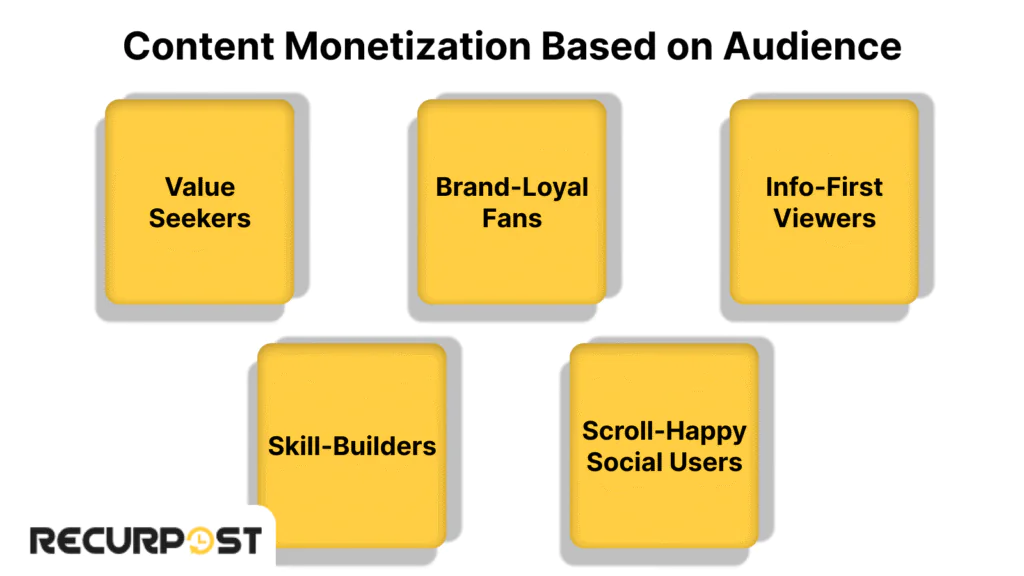
Revenue models must fit audience demographics, content formats, and user behaviors. Each segment links to unique income streams:
Value Seekers
- Content Format: Step-by-step guides, tutorials, comparison content
- Monetization Path: Affiliate marketing through networks like Amazon Associates
- Platform Fit: WordPress blogs, YouTube channels, Facebook monetization tools
Brand-Loyal Fans
- Content Format: Behind-the-scenes reels, product drops, creator diaries
- Monetization Path: Premium access, early releases, exclusive merchandise
- Platform Fit: Facebook Professional Dashboard, Patreon, Instagram subscriptions
Info-First Viewers
- Content Format: Long videos, expert interviews, explainers
- Monetization Path: In-stream ads, display ads, Google AdSense
- Platform Fit: YouTube Partner Program, blogs
Skill-Builders
- Content Format: Online classes, templates, toolkits, downloads
- Monetization Path: Online courses, premium guides, paid downloads
- Platform Fit: Gumroad, personal sites, Thinkific
Scroll-Happy Social Users
- Content Format: Short videos, trending clips, product demos
- Monetization Path: Sponsored posts, branded content, performance bonuses
- Platform Fit: TikTok, Instagram Reels, Facebook monetization tools
Get Clients for Your Marketing Agency with 7 Methods
The Future of Content Earnings in 2025
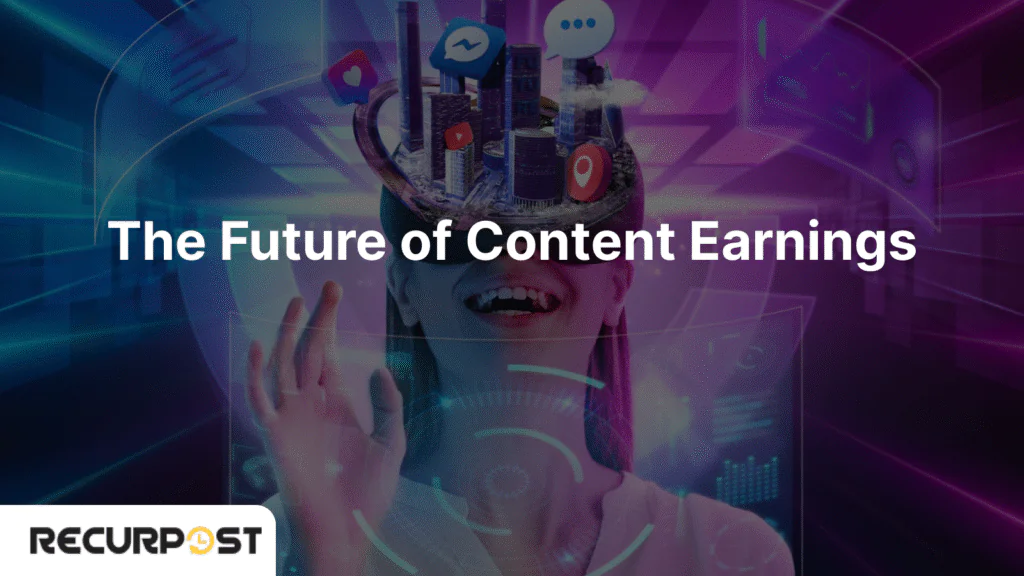
In 2025, the digital media monetization arena will favor both new and established creators, with evolving features and tools driving new income streams across every major platform.
1. Monetization will be open to more creators
Facebook content monetization beta and YouTube Studio continue to expand monetization programs, simplifying the application process and allowing nano-influencers to qualify earlier. This shift increases the creator population eligible for platform payouts and performance bonus programs.
Now, even micro-communities and smaller channels can participate in the broader creator economy, gaining access to new income streams without needing a massive following.
2. Micro-content will generate real income
The growth of the micro-content economy is transforming how creators earn. Short posts, text updates, and free materials now direct targeted traffic to affiliate networks, advertisements, and digital products through precise targeting and faster payout systems.
Micro-content monetization enables creators to benefit from shoppable content, affiliate clicks, and sponsored promotions, scaling revenue as new models emerge.
3. Dashboards will power smarter decisions.
Advanced professional dashboards, monetization tabs, and real-time analytics guide every content move. Platforms like Creator Studio and Meta Business Suite operate as data dashboards, centralizing analytics to maximize audience engagement, improve watch time, and enable true data-driven decisions. These tools now form the backbone of modern digital asset monetization operations.
4. Premium and niche content will thrive.
Niche creators providing online courses, branded tutorials, and unique digital offerings are now outperforming generalists in revenue per subscriber and lifetime value. On top monetization platforms, specialized premium content sales and branded content attract engaged micro-communities, raising digital content profitability for those willing to focus on specific categories. The creator economy continues to reward expertise and specialization, driving momentum for creators in every niche.
5. Consistency will matter more than follower count.
Quality content creators who maintain publishing consistency using tools such as RecurPost or automated content creation platforms earn more stable monthly recurring revenue and see a better retention rate. Here, consistency over follower count proves more predictive for sustainable revenue optimization than chasing sporadic viral success. The move to steady output reflects the ongoing shift in digital publishing, where direct partnerships and reliable delivery drive long-term results.
6. More content formats will become monetizable.
Today, nearly every format from long-form video and live streaming to podcasts, carousels, and mini-reels connects to unique payout models, ad-based monetization, or affiliate opportunities. As monetization programs evolve, creators can use content diversification as their best risk management strategy and tap into new revenue models as soon as they launch.
Tools That Power Content Monetization
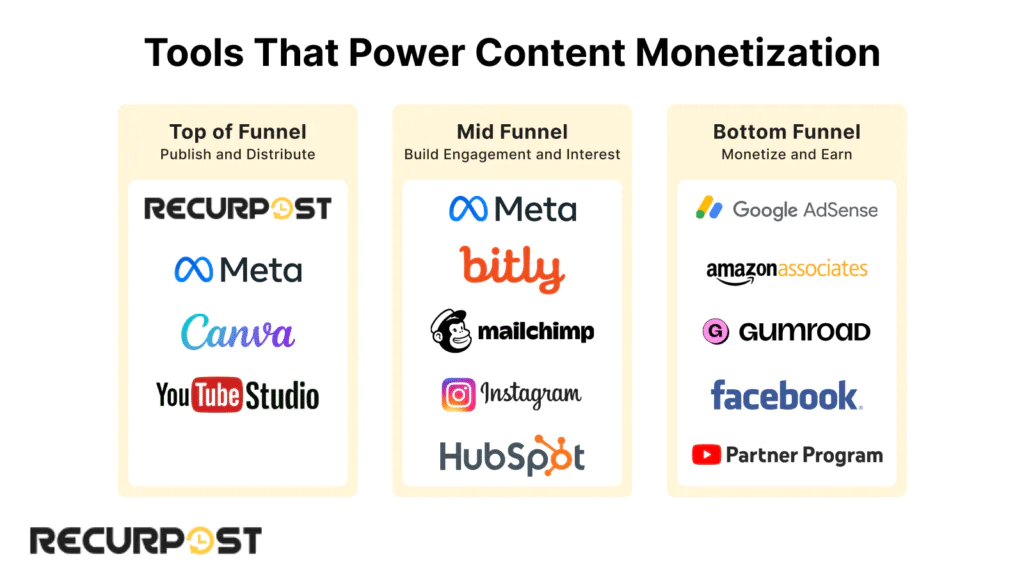
Whether you’re a creator, marketer, or real estate professional, the right tools determine how efficiently you generate revenue from digital content. Content monetization services help structure your tech stack for every content stage, matching features to each format, scheduling tools like RecurPost, analytics platforms, and revenue management systems all work together to maximize digital content profitability.
Top of Funnel: Publish and Distribute
Goal: Stay consistent and visible across social media platforms
Audience: Value seekers, brand-loyal fans, scroll-happy social users
Use these tools:
- RecurPost: Schedule and recycle text posts, short-form content, and blog posts across multiple platforms for consistent publishing.
- Meta Business Suite: Manage content, access the professional dashboard, and monitor Facebook content monetization for performance tracking and payout history.
- Canva: Design branded visuals, listing graphics, and templates for eye-catching micro-content, reels, and sponsored posts.
- YouTube Studio: Publish walkthroughs, property showcases, tutorials, or FAQs on the go and monitor analytics data monetization for improved channel growth.
Mid Funnel: Build Engagement and Interest
Goal: Create interaction, clicks, and conversions
Audience: Info-first viewers, skill-builders, micro-communities
Use these tools:
- Facebook Creator Studio: Track video views, unlock performance bonus opportunities, manage monetization tabs, and analyze digital asset monetization trends.
- Bitly: Shorten and track clicks to affiliate networks, landing pages, or audience monetization forms for campaigns.
- Mailchimp: Send newsletters, premium content, or exclusive property tours to segmented email lists and automate audience monetization.
- Instagram Creator Tools: Analyze stories, reels, sponsored posts, and branded content for engagement and conversion rate insights.
- HubSpot CRM: Manage warm leads and follow up from content views, ideal for professionals targeting niche communities and monitoring content value extraction.
Bottom Funnel: Monetize and Earn
Goal: Turn content into actual revenue
Audience: Monetizing creators, publishers, digital asset owners
Use these tools:
- Google AdSense: Monetize blog posts, community updates, or expert guides with display ads, optimizing your payout model and maximizing ad-based monetization.
- Amazon Associates: Add affiliate links for kitchen tools, tech, or home décor to tutorials, reviews, or property content for recurring commission.
- Gumroad: Sell online courses, buyer guides, and neighborhood handbooks, supporting revenue diversification and digital product monetization.
- Facebook Professional Dashboard: Check payout history, track content quality, send invitations, and analyze revenue streams through data dashboards.
- YouTube Partner Program: Earn from in-stream ads, property tours, long-form videos, and track performance using detailed analytics data monetization.
Turn Data into Income for Content Monetization
The content is out. Views are in. Now it’s time to let analytics drive which content earns the best. Smart creators use analytics data monetization, not gut feelings, to power sustainable revenue.
What to Track
- Clicks: Measure which posts or links drive actions, especially for affiliate marketing, branded content, or digital products. A high conversion rate shows what resonates.
- Watch Time: Longer engagement improves revenue per subscriber from in-stream ads, the YouTube Partner Program, or Facebook content monetization beta.
- Top Content Formats: Compare text posts, blog posts, and short-form clips to reveal formats with the highest audience monetization.
- Revenue Channels: Track earnings from ad-based monetization, affiliate links, or sponsored posts to spot strong revenue streams.
- Retention Rate: Monitor how well you keep viewers and repeat readers. Higher retention leads to more recurring income.
Where to Look Inside the Tools You Already Use
- Facebook Professional Dashboard: Review content performance, payout insights, eligibility for the monetization tab, and performance bonus progress.
- YouTube Studio: Analyze watch time trends, ad earnings, and audience growth for data-driven platform selection.
- AdSense Dashboard: Find granular page-level stats to pinpoint which guides or blog posts yield the most ad revenue.
- Amazon Associates: Track click-throughs, conversion rates, and which products drive the highest affiliate commissions.
- RecurPost: Study your post history to spot top-performing time slots and formats, boosting monetized traffic and optimizing your content calendar.
What Successful Creators Are Doing
- A digital coach uses analytics to compare sales from online courses and premium content, adjusting her content plan each month to increase revenue per subscriber.
- A home organization creator links high-performing videos to trending kitchen tools through affiliate networks, driving steady passive income generation.
- A real estate content pro times walkthrough uploads for peak engagement, maximizing performance bonus earnings from Facebook content monetization beta.
How RecurPost Helps You Monetize Social Media
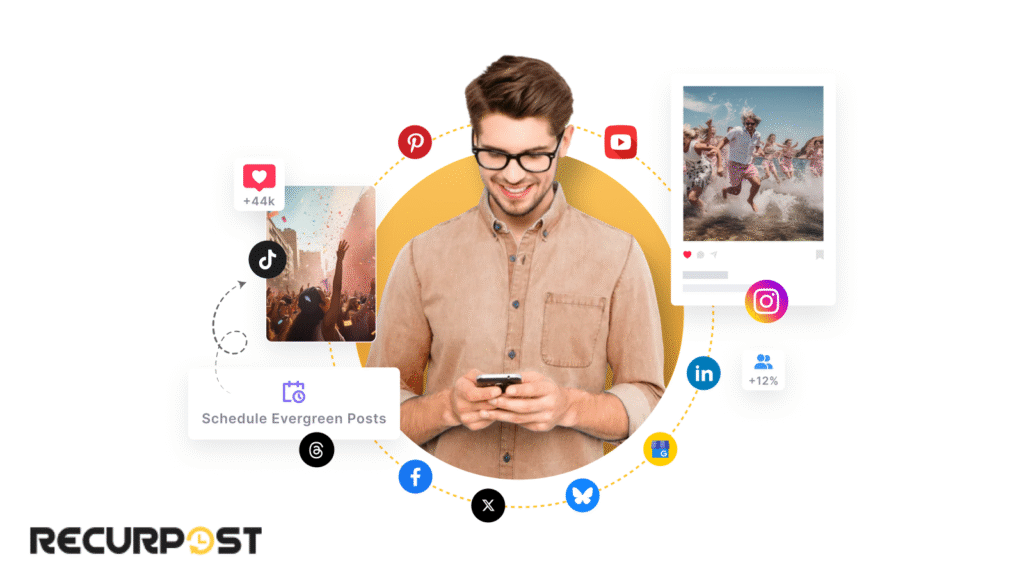
RecurPost empowers creators to boost social media content monetization without creating new posts every week. With automated content monetization, your highest-earning blog posts, micro-content, and videos keep working across every major platform, driving recurring income from each scheduled share.
Here’s how RecurPost fits into your content monetization strategy:
- Reshare top-performing content: Give your best evergreen blog posts, product reviews, or short-form videos new life, keeping high engagement rates and sales active with every reshare.
- Save time for revenue-generating work: Free up more hours to develop premium digital products, membership sites, or affiliate marketing campaigns instead of manual reposting.
- Maintain publishing consistency: Schedule posts for Facebook, Instagram, LinkedIn, and other social channels to maximize reach, grow your audience, and support micro-content monetization from a single dashboard.
- Integrate with key monetization tools: Seamlessly match every scheduled post to your Facebook content monetization, Google AdSense, or affiliate networks, ensuring every share links back to your revenue streams.
- Automate smarter, not harder: Let RecurPost manage everything, sponsored posts, YouTube channel links, or monetization tab announcements, so you earn more from each platform with less effort.
Common Mistakes That Limit Your Earnings
Skipping these basics can stall your digital content profitability, even with frequent posting and active channels.
- No clear monetization path: Sharing posts without linking to affiliate networks, integrating ads, or setting up a payout model means missing out on potential recurring income and lowering your conversion rate.
- Ignoring monetization requirements: Overlooking YouTube Partner Program or Facebook content monetization approval steps, or not following monetization criteria, can block access to payout history, performance bonus offers, or delay earnings.
- Low content quality: High publishing consistency won’t help if content doesn’t meet audience expectations for value, relevance, or engagement.
- No analytics or data tracking: Failing to use the professional dashboard, AdSense reports, or affiliate analytics leaves revenue gaps. Proper data tracking boosts both audience monetization and platform selection.
- Using the same format everywhere: Applying the same approach across all social media platforms ignores key differences in content monetization strategies. What works for a YouTube channel might not deliver results on TikTok, Facebook, or Instagram.
Conclusion
Content creation has evolved into true content commercialization, turning blog posts, tutorials, and even micro-content into ongoing revenue streams. Today’s creators use content diversification, mixing short-form posts, guides, and branded videos to achieve recurring income and grow digital asset monetization across every major social media platform.
You don’t need a huge following or big brand deals to succeed. Audience engagement thrives when you prioritize publishing consistency, experiment with new formats, and choose the right tools for each channel. The path to sustainable income is built on steady content recycling, smart platform selection, and data-driven decisions that boost revenue optimization over time.
With more platforms now sending monetization invitations to active creators, new doors open for affiliate marketing, digital product sales, and mobile content scheduling. The most successful creators monitor their analytics, adapt their content mix, and use every post as an opportunity to build lasting value.
Your strategy(how you plan, track, and share) defines your monetization results in the evolving creator economy.
FAQs on Content Monetization
1. Can I monetize content created entirely on a mobile device?
Yes. Many content creators use Android apps to create, edit, and post. Platforms like YouTube, Instagram, and Facebook support full content workflows, including access to the professional dashboard and monetization tab from mobile.
2. What’s the best way to combine content monetization with email marketing?
Link your content formats to a lead magnet (like a digital product or guide). Use email to drive traffic back to your blog posts, affiliate links, or branded content offers. It’s a simple way to increase reach and trigger affiliate network conversions.
3. Do platforms penalize reposting monetized content across channels?
No, but each platform has different rules. Always format your videos, text posts, or ads to fit platform guidelines. For example, what works for Facebook content monetization might need trimming or repackaging for Shorts or Reels.
4. Is there a way to track which content format earns the most?
Yes. Most monetization platforms offer content-level insights through their dashboards. You can compare performance across sponsored posts, in-stream ads, or affiliate marketing placements, helping you decide where to double down.
5. How can I start earning money from my existing content?
You can start earning by joining content monetization programs like YouTube Partner Program, Facebook Content Monetization, or Instagram Subscriptions. Add affiliate links, enable ads, or offer premium access on your blog posts, videos, or social media. Consistent posting and engaging content increase your revenue opportunities.
6. How do you monetize your social media presence?
Monetize your social media presence by joining Facebook content monetization, Instagram monetization, or the YouTube Partner Program. Add affiliate links, run ads, create sponsored posts, and launch subscription programs. Consistency and engagement drive the best results.
7. How do you monetize digital content?
Monetize digital content by enabling ads with Google AdSense, using affiliate marketing, selling online courses, or offering paywalled content. Choose formats like tutorials or product reviews that suit your audience. Use analytics to track what earns the most.
8. What are the best content monetization strategies for creators in 2025?
The best monetization strategies include ad-based monetization, affiliate marketing, sponsored content, premium access, and subscription programs. Use a mix of these, like Google AdSense for blogs, Amazon Associates for product reviews, and platform subscriptions for exclusive content, to diversify your revenue streams. Matching each strategy to your audience and content format delivers the most consistent earnings.
9. What are the best practices for content monetization?
Create high-quality, original content and post consistently across platforms like YouTube, Facebook, and Instagram. Follow each platform’s monetization policies, track performance using analytics, and diversify your revenue streams with ads, affiliate marketing, and sponsored content. Always focus on audience engagement and adapt your strategy based on what works best.
10. How to earn money on social media platforms?
Earn money on social media platforms by using monetization features such as ads, affiliate marketing, sponsored content, and paid subscriptions. Join programs like Facebook Content Monetization, YouTube Partner Program, or Instagram Subscriptions. Focus on growing your audience and posting engaging content to unlock more revenue streams.

Ruchi Dhimar is a skilled content writer with 5 years of experience. She is passionate about crafting compelling narratives, specializing in writing content for different industries.





